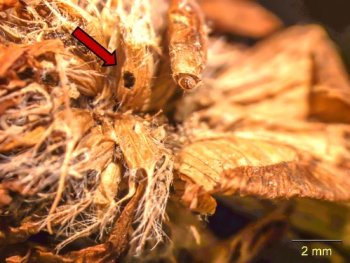
On 13 December 2017, moths were treated with field rates of Mavrik® (a.i. 240 g/l tau-fluvalinate), Lorsban (a.i. 500 g/l chlorpyrifos), Karate Zeon® (a.i. 250 g/l lambda cyhalothrin) and Exirel® (a.i. 100 g/l cyantraniliprole. Control treatments were water only and water plus adjuvant. Each treatment was replicated eight times with 7-8 moths in each dish.
Moths were placed into 150 mm Petri dishes lined with filter paper and confined with a coarse metal mesh lid. Treatments were applied using a knapsack sprayer. At the completion of application, dishes were transferred to a controlled environment room (18oC, natural light) where the mortality assessments were made. At the completion of the mortality assessments, dishes were sprayed with tap water and loosely covered with plastic lids.
Assessment took place approximately 4.5, 24 and 48 hours following treatment.
Results
There was rapid mortality using Mavrik®, Karate Zeon® and Lorsban™ 50EC following application as evidenced by high mortality after only 4.5 hours following treatment.
FAR says that the results provide a promising indication that some of the insecticides currently used provide effective control of red clover casebearer moth. However, the provisos are that in the field, adults may not receive a direct application due to location in the foliage. In addition, female moths may be less mobile and therefore not come into contact with residues.
The industry body suggests that growers always consult their agrichemical adviser before implementing control measures and practice bee-safe application techniques.
Additional information
Details of what FAR knows to date are outlined below:
- Red clover casebearer is a small moth (about 8mm long) and is very similar to two other species of clover casebearer moth (Coleophora spp.) that are already well established in white clover in New Zealand. The principal host plant of red clover casebearer is red clover, although it has occasionally been reported overseas as damaging other clover species (including white clover, haresfoot trefoil);
- Adult moths are expected to be seen in New Zealand from October-December. Eggs are laid by the female moths at the base of florets and the larvae feed on developing seeds in the florets over summer from inside their ‘cases’. The first signs of low level damage are holes found in individual red clover florets;
- The moth overwinters as mature larvae typically near the soil surface or in leaf litter. The larvae then pupate and emerge as adults the following spring/summer;
- Currently (December 2017), red clover casebearer has been confirmed from North Otago to North Canterbury, and is likely to have been present for some time. It is also likely to be present throughout the South Island and into southern North Island;
- A small number of parasitoid species are already present in New Zealand introduced to control the Coleophora spp. found in white clover. These parasitoids attack the larvae, and may prove effective control agents for red clover casebearer in the future.
Source: FAR



 Classifieds
Classifieds

